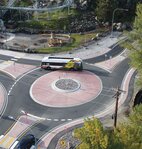

CHELAN – Nick Covey, CEO of Link Transit, addressed the regular bi-monthly meeting of the Chelan city council on Feb. 27 with a presentation that included everything short of driving an electric bus through the council chamber doors.
Covey began with some background details.
Link has service options to cover every commuter need.
The Link fleet provides a variety of vehicles, and all are ADA-compliant.
“Batteries usually last about half the life of the vehicle,” said Covey. “The big busses are 12-year, 500,000-mile vehicles. BYD warranties their batteries for 12 years. If something goes wrong, they replace them for us,”
Covey explained the benefit of not having to replace batteries that can cost half the price of a bus. BYD also buys the used batteries back from Link, eliminating the need for battery disposal.
To help keep some of its vehicles charging while in service Link employs a series of wireless inductive charging locations.
“This is in-ground charging the bus drives over,” said Covey, “It’s 300 kilowatts. One minute of charging gives us about two additional miles.”
For some downtown and urban Wenatchee routes of 200-250 miles with bus ranges of 130 miles, the wireless chargers provides busses with enough extended range to operate 15 hours a day. Link has four of the grant-funded $500,000 chargers, three at Columbia Station and one in Leavenworth. One will be installed in the East Wenatchee Park and Ride and another in Manson.
Link capital projects for 22024 include:
Other projects include the Apple Blossom Center for a possible park and ride as that area population grows. Another park and ride at Leffler Field in Manson will include a wireless charger.
Link is working with TREAD, that Covey describes as “a local area nonprofit that has been very instrumental in bike pathways,” on Chelan-to-Manson, Wenatchee-to-Leavenworth, Wenatchee-to-Rock Island, and Wenatchee-to-Malaga pathway designs.
“Part of those pathways will hook up to bus stops and pullouts so you can put your bike on the bus, or we can drop you off so you can ride on the pathway safely,” Covey said.
Vision 2020 recap
Based on a successful 2019 campaign that raised additional revenue. Link embarked on a six-year Vision 2020 plan including 30-plus projects in Chelan and Douglas counties. As of Covey’s report the plan is ahead of projections with about 74 percent completed ahead of the 63 percent estimated at this stage. Just one of those is a new Sunday service implemented for the first time in agency history.
A word about free fares
Link weathered the 1999 I-695 excise tax measure approved by voters that rolled back vehicle excise taxes to $30.
“Half the funding for transit was in that motor vehicle excise tax, so we lost that,” Covey said.
In 2020 Link moved into its new building at Olds Station and laid off half its staff.
“It was a tough time,” said Covey, “so we implemented fares to try and regain some of that revenue. At best we got about five percent of our revenue from fares.
“When Covid hit everybody in the state went fare free,” said Covey. “Once Covid got over we decided to keep it that way.”
“Fares displace the folks who really need it most,” said Covey who explained that the two-way fare costs for a low-income family with children was unaffordable for many.
Link’s free fares also meet nearly half a dozen Federal criteria that qualify the transit service to receive more than a half-million dollars per incentive.
“Right now, we are receiving five of those,” said Covey. “That’s a substantial chunk of money that fares would never come close to replacing. It’s better for us to keep it fare-free and to keep those incentives.”
Mike Maltais: 360-333-8483 or michael@ward.media
Comments
No comments on this item Please log in to comment by clicking here